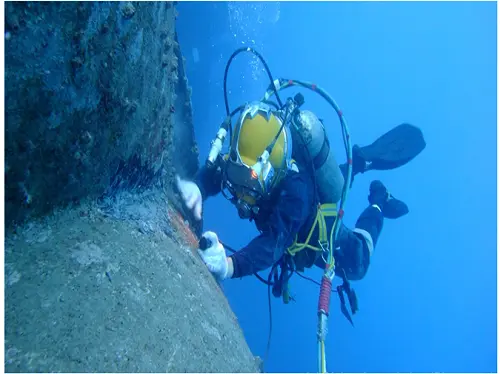
Underwater ship repair is a critical aspect of marine maintenance, enabling vessels to stay operational without the need for costly and time-consuming dry docking. However, the process is not without its challenges. From adverse environmental conditions to technical and logistical difficulties, underwater repairs require a combination of skill, precision, and innovation to overcome these obstacles. In this blog, we explore the most common challenges faced during underwater ship repair and how they are addressed.
1. Limited Visibility
One of the most significant challenges in underwater repairs is poor visibility. Factors like murky water, low light conditions, and turbidity can make it difficult for divers to see what they’re working on.
Solutions:
- Use high-intensity underwater lighting systems.
- Employ sonar and imaging tools to create detailed visuals of the repair area.
- Equip divers with visibility-enhancing helmets and cameras to provide real-time feedback to surface teams.
2. Strong Currents and Tides
Ocean currents and tidal movements can create unstable working conditions, increasing the risk to divers and affecting the precision of repairs.
Solutions:
- Schedule repairs during slack tides when currents are minimal.
- Use tethering systems to secure divers and equipment.
- Deploy underwater robotics to handle repairs in areas with strong currents.
3. Difficult-to-Access Areas
Some parts of the ship, such as the keel, rudder, or sea chests, are hard to reach due to their location or surrounding obstructions.
Solutions:
- Use compact, remote-controlled robotic tools for precision work.
- Train divers in advanced maneuvering techniques for confined spaces.
- Develop custom tools to address specific repair needs.
4. Marine Growth and Fouling
Barnacles, algae, and other marine organisms can obscure damage and make it harder to perform repairs. Heavy fouling can also affect the adhesion of repair materials.
Solutions:
- Conduct thorough cleaning of the repair area using rotary brushes, scrapers, or high-pressure water jets.
- Apply antifouling coatings post-repair to prevent future growth.
- Use environmentally friendly cleaning methods to minimize ecological impact.
5. Equipment Malfunctions
Underwater tools and machinery are subject to extreme pressure, saltwater exposure, and continuous use, increasing the likelihood of breakdowns during repairs.
Solutions:
- Perform regular maintenance and testing of all underwater equipment.
- Use corrosion-resistant materials for tools and machinery.
- Keep backup equipment readily available for emergencies.
6. Safety Risks for Divers
Diving for underwater repairs comes with inherent risks, including decompression sickness, entanglement, and exposure to toxic substances.
Solutions:
- Provide divers with advanced training and certifications.
- Ensure all safety protocols are strictly followed, including the use of communication systems and redundant air supplies.
- Monitor diver health closely and limit underwater exposure times.
7. Environmental Challenges
Adverse weather, freezing temperatures, and underwater hazards like debris or marine life can complicate repair operations.
Solutions:
- Monitor weather forecasts and delay repairs during severe conditions.
- Use protective gear and heated diving suits for cold environments.
- Conduct thorough site surveys to identify and mitigate potential hazards.
8. Structural Complexity of Modern Ships
Modern vessels have intricate designs and specialized materials that require advanced techniques for repairs.
Solutions:
- Train repair teams in handling modern materials such as composites and alloys.
- Utilize advanced diagnostic tools to accurately assess damage.
- Partner with manufacturers to obtain technical support and resources.
9. Time Constraints
Repairs often need to be completed within tight deadlines to minimize downtime and financial losses for the shipowner.
Solutions:
- Use well-coordinated teams to handle repairs efficiently.
- Employ pre-fabricated repair components for faster installation.
- Leverage robotics and automation to accelerate routine tasks.
10. Cost Management
Underwater repairs can be expensive due to specialized equipment, labor, and logistical requirements.
Solutions:
- Optimize repair schedules to reduce operational interruptions.
- Use multi-skilled teams to handle various aspects of the repair.
- Invest in preventive maintenance to minimize the need for extensive repairs.
Conclusion
Underwater ship repair is a complex yet essential part of maritime operations. While challenges like poor visibility, strong currents, and safety risks can complicate the process, advancements in technology, coupled with skilled professionals, are making these repairs more efficient and reliable. By understanding and addressing these common obstacles, the maritime industry can ensure vessels remain seaworthy while reducing downtime and costs.
Underwater repair isn’t just a necessity—it’s a testament to the resilience and ingenuity of the marine industry.
